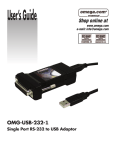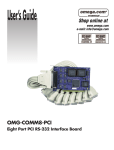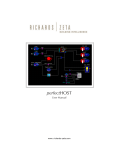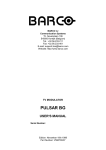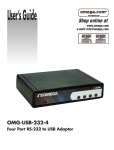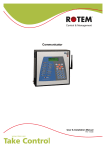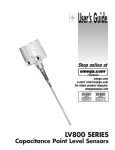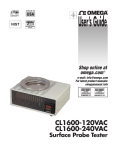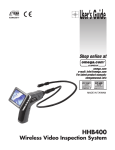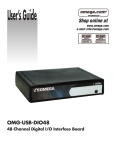Download Omega Vehicle Security OMG-COMM232-PCI User's Manual
Transcript
User’s Guide Shop online at www.omega.com e-mail: [email protected] OMG-COMM232-PCI Dual Port PCI RS-232 Interface Board OMEGAnet ® Online Service www.omega.com Internet e-mail [email protected] Servicing North America: USA: ISO 9001 Certified Canada: One Omega Drive, P.O. Box 4047 Stamford CT 06907-0047 TEL: (203) 359-1660 e-mail: [email protected] 976 Bergar Laval (Quebec) H7L 5A1, Canada TEL: (514) 856-6928 e-mail: [email protected] FAX: (203) 359-7700 FAX: (514) 856-6886 For immediate technical or application assistance: USA and Canada: Sales Service: 1-800-826-6342 / 1-800-TC-OMEGA® Customer Service: 1-800-622-2378 / 1-800-622-BEST® Engineering Service: 1-800-872-9436 / 1-800-USA-WHEN® TELEX: 996404 EASYLINK: 62968934 CABLE: OMEGA Mexico: En Espan˜ol: (001) 203-359-7803 FAX: (001) 203-359-7807 e-mail: [email protected] [email protected] Servicing Europe: Benelux: Postbus 8034, 1180 LA Amstelveen, The Netherlands TEL: +31 (0)20 3472121 FAX: +31 (0)20 6434643 Toll Free in Benelux: 0800 0993344 e-mail: [email protected] Czech Republic: Frystatska 184, 733 01 Karviná, Czech Republic TEL: +420 (0)59 6311899 FAX: +420 (0)59 6311114 Toll Free: 0800-1-66342 e-mail: [email protected] France: 11, rue Jacques Cartier, 78280 Guyancourt, France TEL: +33 (0)1 61 37 29 00 FAX: +33 (0)1 30 57 54 27 Toll Free in France: 0800 466 342 e-mail: [email protected] Germany/Austria: Daimlerstrasse 26, D-75392 Deckenpfronn, Germany TEL: +49 (0)7056 9398-0 Toll Free in Germany: 0800 639 7678 e-mail: [email protected] United Kingdom: ISO 9002 Certified FAX: +49 (0)7056 9398-29 One Omega Drive, River Bend Technology Centre Northbank, Irlam, Manchester M44 5BD United Kingdom TEL: +44 (0)161 777 6611 FAX: +44 (0)161 777 6622 Toll Free in United Kingdom: 0800-488-488 e-mail: [email protected] It is the policy of OMEGA to comply with all worldwide safety and EMC/EMI regulations that apply. OMEGA is constantly pursuing certification of its products to the European New Approach Directives. OMEGA will add the CE mark to every appropriate device upon certification. The information contained in this document is believed to be correct, but OMEGA Engineering, Inc. accepts no liability for any errors it contains, and reserves the right to alter specifications without notice. WARNING: These products are not designed for use in, and should not be used for, patient-connected applications. Contents INTRODUCTION..........................................................................1 OVERVIEW................................................................................................ 1 W HAT ’S INCLUDED ................................................................................ 1 FACTORY DEFAULT SETTINGS ............................................................ 1 CARD SETUP ..............................................................................2 A DDRESS AND IRQ SELECTION ............................................................ 2 CLOCK M ODES ........................................................................................ 2 BAUD RATES AND DIVISORS FOR THE ‘DIV2’ MODE ........................ 3 BAUD RATES AND DIVISORS FOR THE ‘DIV1’ MODE ........................ 5 INSTALLATION ..........................................................................7 OPERATING SYSTEM INSTALLATION ................................................. 7 W INDOWS 95/98/NT............................................................................... 7 W INDOWS 3.1X........................................................................................ 7 DOS........................................................................................................... 7 OTHER OPERATING SYSTEMS.............................................................. 7 HARDWARE INSTALLATION ................................................................. 7 TECHNICAL DESCRIPTION .........................................................8 INTERRUPTS ............................................................................................ 8 W HY USE AN ISP?................................................................................... 9 CONNECTOR PIN A SSIGNMENTS.......................................................... 9 RS-232.................................................................................................... 9 SPECIFICATIONS ......................................................................10 ENVIRONMENTAL SPECIFICATIONS.................................................. 10 M ANUFACTURING ................................................................................ 10 POWER CONSUMPTION........................................................................ 10 M EAN TIME BETWEEN FAILURES (MTBF) ..................................... 10 PHYSICAL DIMENSIONS........................................................................ 10 APPENDIX A - TROUBLESHOOTING .........................................11 APPENDIX B - HOW TO GET ASSISTANCE ..............................12 APPENDIX C - ELECTRICAL INTERFACE...................................13 RS-232.................................................................................................... 13 APPENDIX D - ASYNCHRONOUS COMMUNICATIONS ...............14 APPENDIX E - SILK-SCREEN ....................................................15 APPENDIX F - COMPLIANCE NOTICES .....................................16 FEDERAL COMMUNICATIONS COMMISSION STATEMENT ............ 16 EMC DIRECTIVE STATEMENT ........................................................... 16 Figures Figure 1 - Clocking Mode 'Divide By 4’............................................................2 Figure 2 - Clocking Mode 'Divide By 2’............................................................3 Figure 3 - Clocking Mode 'Divide By 1’............................................................5 Figure 4 - Asynchronous Communications Bit Diagram.............................14 © 1998f Omega Engineering, Incorporated. All rights reserved. Introduction Introduction Overview The Omega Engineering OMG-COMM+232.PCI is a two channel PCI Bus serial I/O adapter for the PC and compatibles. It provides two RS-232 serial ports supporting data rates up to 460.8K bps. The OMG-COMM+232.PCI works seamlessly with the standard operating system serial driver. UART upgrades are available providing 32 and 64 byte FIFOs. What’s Included The OMG-COMM+232.PCI is shipped with the following items. If any of these items are missing or damaged, contact the supplier. • • • OMG-COMM+232.PCI Serial I/O Adapter Serial Utility Software User Manual Factory Default Settings The OMG-COMM+232.PCI factory default settings are as follows: Port # Port 1 Port 2 Clock Mode DIV4 DIV4 To install the OMG-COMM+232.PCI using factory default settings, refer to Installation on page 7. For your reference, record installed OMG-COMM+232.PCI settings below: Port # Port 1 Port 2 Omega Engineering COMM+232.PCI Clock Mode Page 1 Card Setup Card Setup Address and IRQ selection The OMG-COMM+232.PCI is automatically assigned I/O addresses and IRQs by your motherboard BIOS. Only the I/O address may be modified by the user. Adding or removing other hardware may change the assignment of I/O addresses and IRQs. Clock Modes The OMG-COMM+232.PCI employs a unique clocking option that allows the end user to select from divide by 4, divide by 2 and divide by 1 clocking modes. These modes are selected at Headers J1C through J4C. DIV1 DIV2 DIV4 To select the Baud rates commonly associated with COM: ports (i.e. 2400, 4800, 9600, 19.2, … 115.2K Bps ) place the jumper in the divide by 4 mode (silk-screen DIV4) position. Figure 1 - Clocking Mode 'Divide By 4’ Omega Engineering COMM+232.PCI Page 2 Card Setup DIV1 DIV2 DIV4 To double these rates up to a maximum rate of 230.4K bps place the jumper in the divide by 2 (silk-screen DIV2) position. Figure 2 - Clocking Mode 'Divide By 2’ Baud Rates and Divisors for the ‘DIV2’ mode The following table shows some common data rates and the rates you should choose if using the adapter in the ‘DIV2’ mode. For this Data Rate 1200 bps 2400 bps 4800 bps 9600 bps 19.2K bps 38.4K bps 57.6 K bps 115.2 K bps 230.4 K bps Choose this Data Rate 600 bps 1200 bps 2400bps 4800 bps 9600 bps 19.2K bps 28.8K bps 57.6 K bps 115.2 K bps If your communications package allows the use of Baud rate divisors, choose the appropriate divisor from the following table: For this Data Rate 1200 bps 2400 bps 4800 bps 9600 bps 19.2K bps 38.4K bps 57.6K bps 115.2K bps 230.4K bps Omega Engineering COMM+232.PCI Choose this Divisor 192 96 48 24 12 8 4 2 1 Page 3 Notes Page Omega Engineering COMM+232.PCI Page 4 Card Setup DIV1 DIV2 DIV4 To select the maximum data rate (460.8K bps) place the jumper in the divide by 1 (silk-screen DIV1) position. Figure 3 - Clocking Mode 'Divide By 1’ Baud Rates and Divisors for the ‘DIV1’ mode The following table shows some common data rates and the rates you should choose if using the adapter in the ‘DIV1’ mode. For this Data Rate 1200 bps 2400 bps 4800 bps 9600 bps 19.2K bps 57.6 K bps 115.2 K bps 230.4K bps 460.8K bps Choose this Data Rate 300 bps 600 bps 1200 bps 2400 bps 4800 bps 14.4K bps 28.8K bps 57.6 K bps 115.2 K bps If your communications package allows the use of Baud rate divisors, choose the appropriate divisor from the following table: For this Data Rate 1200 bps 2400 bps 4800 bps 9600 bps 19.2K bps 38.4K bps 57.6K bps 115.2K bps 230.4K bps 460.8K bps Omega Engineering COMM+232.PCI Choose this Divisor 384 192 96 48 24 12 8 4 2 1 Page 5 Notes Page Omega Engineering COMM+232.PCI Page 6 Installation Installation Operating System Installation Windows 95/98/NT Run Setup on Disk 2 of the Serial Utilities Software. Windows 3.1x Refer to the Win3x.hlp file in the \Win31 directory on Disk 1 of the Serial Utilities Software. DOS Refer to the Readme.txt file found in the \DOS directory on Disk 1 of the Serial Utilities Software. Other Operating Systems Refer to the appropriate directory on Disk 1 of the Serial Utilities Software. Hardware Installation The OMG-COMM+232.PCI can be installed in any of the PCI expansion slots and contains several jumper straps for each port that must be set for proper operation. 1. 2. 3. 4. 5. 6. 7. Turn off PC power. Disconnect the power cord. Remove the PC case cover. Locate an available PCI slot and remove the blank metal slot cover. Gently insert the OMG-COMM+232.PCI into the slot. Make sure that the adapter is seated properly. Replace the screw. Replace the cover. Connect the power cord. Installation is complete. Omega Engineering COMM+232.PCI Page 7 Technical Description Technical Description The Omega Engineering OMG-COMM+232.PCI provides a PCI interface adapter with 2 asynchronous serial ports providing a versatile interface for modems, printers and plotters. The OMG-COMM+232.PCI utilizes the 16550 UART. This chip features programmable baud rates, data format, interrupt control and a 16-byte input and output FIFO. Also available as an option is the 16C650 UART that provides a deeper FIFO (32 bytes) and enhanced clocking features. Interrupts A good description of an interrupt and it’s importance to the PC can be found in the book ‘Peter Norton’s Inside the PC, Premier Edition’: “ One of the key things that makes a computer different from any other kind of man-made machine is that computers have the capability to respond to the unpredictable variety of work that comes to them. The key to this capability is a feature known as interrupts. The interrupt feature enables the computer to suspend whatever it is doing and switch to something else in response to an interruption, such as the press of a key on the keyboard.” A good analogy of a PC interrupt would be the phone ringing. The phone ‘bell’ is a request for us to stop what we are currently doing and take up another task (speak to the person on the other end of the line). This is the same process the PC uses to alert the CPU that a task must be preformed. The CPU upon receiving an interrupt makes a record of what the processor was doing at the time and stores this information on the ‘stack’; this allows the processor to resume its predefined duties after the interrupt is handled, exactly where it left off. Every main sub-system in the PC has it’s own interrupt, frequently called an IRQ (short for Interrupt ReQuest). In these early days of PC’s Omega Engineering decided that the ability to share IRQs was an important feature for any add-in I/O card. Consider that in the IBM XT the available IRQs were IRQ0 through IRQ7. Of these interrupts only IRQ2-5 and IRQ7 were actually available for use. This made the IRQ a very valuable system resource. To make the maximum use of these system resources Omega Engineering devised an IRQ sharing circuit that allowed more than one port to use a selected IRQ. This worked fine as a hardware solution but presented the software designer with a challenge to identify the source of the interrupt. The software designer frequently used a technique referred to as ‘round robin Omega Engineering COMM+232.PCI Page 8 Technical Description polling’. This method required the interrupt service routine to ‘poll’ or interrogate each UART as to its interrupt pending status. This method of polling was sufficient for use with slower speed communications, but as modems increased their throughput abilities this method of servicing shared IRQs became inefficient. Why use an ISP? The answer to the polling inefficiency is the Interrupt Status Port (ISP). The ISP is a read only 8-bit register that sets a corresponding bit when an interrupt is pending. Port 1 interrupt line corresponds with Bit D0 of the status port, Port 2 with D1 etc. The use of this port means that the software designer now only has to poll a single port to determine if an interrupt is pending. The ISP is at Base+7 on each port (Example: Base = 280 Hex, Status Port = 287, 28F… etc.). The OMG-COMM+232.PCI will allow any one of the available locations to be read to obtain the value in the status register. Both status ports on the OMG-COMM+232.PCI are identical, so any one can be read. Example: This indicates that Channel 2 has an interrupt pending. Bit Position: Value Read: 7 0 6 0 5 0 4 0 3 0 2 0 1 1 0 0 Connector Pin Assignments RS-232 TD RTS DTR GND RD DCD DSR CTS RI Name Transmit Data Request To Send Data Term Ready Ground Receive Data Data Carrier Detect Data Set Ready Clear To Send Ring Indicator Pin # 3 7 4 5 2 1 6 8 9 Mode Output Output Output Input Input Input Input Input Note: These assignments meet EIA/TIA/ANSI-574 DTE for DB-9 type connectors. Omega Engineering COMM+232.PCI Page 9 Specifications Specifications Environmental Specifications Specification Temperature Range Humidity Range Operating 0º to 50º C (32º to 122º F) 10 to 90% R.H. Non-Condensing Storage -20º to 70º C (-4º to 158º F) 10 to 90% R.H. Non-Condensing Manufacturing • All Omega Engineering Printed Circuit boards are built to U. L. 94V0 rating and are 100% electrically tested. These printed circuit boards are solder mask over bare copper or solder mask over tin nickel. Power Consumption Supply line Rating +12VDC 50 mA -12VDC 50 mA +5 VDC 480 mA Mean Time Between Failures (MTBF) Greater than 150,000 hours. (Calculated) Physical Dimensions Board length Board Height including Goldfingers Board Height excluding Goldfingers Omega Engineering COMM+232.PCI 5.0 inches 4.2 inches 3.875 inches (12.7 cm) (10.66 cm) (9.841 cm) Page 10 Appendix A - Troubleshooting Appendix A - Troubleshooting A Serial Utility Diskette is supplied with the Omega Engineering adapter and will be used in the troubleshooting procedures. By using this diskette and following these simple steps, most common problems can be eliminated without the need to call Technical Support. 1. Identify all I/O adapters currently installed in your system. This includes your on-board serial ports, controller cards, sound cards etc. The I/O addresses used by these adapters, as well as the IRQ (if any) should be identified. 2. Configure your Omega Engineering adapter so that there is no conflict with currently installed adapters. No two adapters can occupy the same I/O address. 3. Make sure the Omega Engineering adapter is using a unique IRQ. While the Omega Engineering adapter does allow the sharing of IRQs, many other adapters (i.e. SCSI adapters & on-board serial ports) do not. The IRQ is typically selected via an on-board header block. Refer to the section on Card Setup for help in choosing an I/O address and IRQ. 4. Make sure the Omega Engineering adapter is securely installed in a motherboard slot. 5. When running DOS, Windows 3.x or other operating systems refer to the Serial Utilities Disk 1 and the User Manual to verify that the Omega Engineering adapter is configured correctly. The supplied software contains a diagnostic program 'SSD' that runs under DOS and will verify if an adapter is configured properly. This diagnostic program is written with the user in mind and is easy to use. Refer to the README.txt file on the supplied diskette for detailed instructions on using 'SSD'. 6. For Windows 95/98 and Windows NT, the diagnostic tool 'WinSSD' is installed in the Omega Engineering folder on the Start Menu during the setup process. First find the ports using the Device Manager, then use 'WinSSD' to verify that the ports are functional. Always use the Omega Engineering diagnostic software when troubleshooting a problem. This will help eliminate any software issues and identify any hardware conflicts Omega Engineering COMM+232.PCI Page 11 Appendix B - How To Get Assistance Appendix B - How To Get Assistance Please refer to Appendix A - Troubleshooting prior to calling Technical Support. 1. Read this manual thoroughly before attempting to install the adapter in your system. 2. When calling for technical assistance, please have your user manual and current adapter settings. If possible, please have the adapter installed in a computer ready to run diagnostics. RETURN AUTHORIZATION MUST BE OBTAINED FROM OMEGA ENGINEERING BEFORE RETURNED MERCHANDISE WILL BE ACCEPTED. AUTHORIZATION CAN BE OBTAINED BY CALLING OMEGA ENGINEERING AND REQUESTING A RETURN MERCHANDISE AUTHORIZATION (RMA) NUMBER. Omega Engineering COMM+232.PCI Page 12 Appendix C – Electrical Interface Appendix C - Electrical Interface RS-232 Quite possibly the most widely used communication standard is RS-232. This implementation has been defined and revised several times and is often referred to as RS-232 or EIA/TIA-232. The IBM PC computer defined the RS-232 port on a 9 pin D sub connector and subsequently the EIA/TIA approved this implementation as the EIA/TIA-574 standard. This standard is defined as the 9-Position Non-Synchronous Interface between Data Terminal Equipment and Data Circuit-Terminating Equipment Employing Serial Binary Data Interchange. Both implementations are in wide spread use and will be referred to as RS-232 in this document. RS-232 is capable of operating at data rates up to 20 Kbps at distances less than 50 ft. The absolute maximum data rate may vary due to line conditions and cable lengths. RS-232 is a single ended or unbalanced interface, meaning that a single electrical signal is compared to a common signal (ground) to determine binary logic states. The RS-232 and the EIA/TIA-574 specification define two types of interface circuits, Data Terminal Equipment (DTE) and Data Circuit-Terminating Equipment (DCE). The OMGCOMM+232.PCI is a DTE device. Omega Engineering COMM+232.PCI Page 13 Appendix D - Asynchronous Communications Appendix D - Asynchronous Communications Serial data communications implies that individual bits of a character are transmitted consecutively to a receiver that assembles the bits back into a character. Data rate, error checking, handshaking, and character framing (start/stop bits) are pre-defined and must correspond at both the transmitting and receiving ends. Asynchronous communications is the standard means of serial data communication for PC compatibles and PS/2 computers. The original PC was equipped with a communication or COM: port that was designed around an 8250 Universal Asynchronous Receiver Transmitter (UART). This device allows asynchronous serial data to be transferred through a simple and straightforward programming interface. A start bit, followed by a pre-defined number of data bits (5, 6, 7, or 8) defines character boundaries for asynchronous communications. The end of the character is defined by the transmission of a pre-defined number of stop bits (usual 1, 1.5 or 2). An extra bit used for error detection is often appended before the stop bits. Idle state of line 5 to 8 Data Bits Odd, Even or Unused Remain Idle or next start bit 1 P BIT STOP 0 1 1.5 2 Figure 4 - Asynchronous Communications Bit Diagram This special bit is called the parity bit. Parity is a simple method of determining if a data bit has been lost or corrupted during transmission. There are several methods for implementing a parity check to guard against data corruption. Common methods are called (E)ven Parity or (O)dd Parity. Sometimes parity is not used to detect errors on the data stream. This is refereed to as (N)o parity. Because each bit in asynchronous communications is sent consecutively, it is easy to generalize asynchronous communications by stating that each character is wrapped (framed) by pre-defined bits to mark the beginning and end of the serial transmission of the character. The data rate and communication parameters for asynchronous communications have to be the same at both the transmitting and receiving ends. The communication parameters are baud rate, parity, number of data bits per character, and stop bits (i.e. 9600,N,8,1). Omega Engineering COMM+232.PCI Page 14 Appendix E - Silk-Screen Appendix E - Silk-Screen 5.0" 4.2" Omega Engineering COMM+232.PCI Page 15 Warranty Appendix F - Compliance Notices Federal Communications Commission Statement FCC - This equipment has been tested and found to comply with the limits for Class A digital device, pursuant to Part 15 of the FCC Rules. These limits are designed to provide reasonable protection against harmful interference when the equipment is operated in a commercial environment. This equipment generates, uses, and can radiate radio frequency energy and, if not installed and used in accordance with the instruction manual, may cause harmful interference to radio communications. Operation of this equipment in a residential area is likely to cause harmful interference in such case the user will be required to correct the interference at his own expense. EMC Directive Statement Products bearing the CE Label fulfill the requirements of the EMC directive (89/336/EEC) and of the low-voltage directive (73/23/EEC) issued by the European Commission. To obey these directives, the following European standards must be met: • EN55022 Class A - “Limits and methods of measurement of radio interference characteristics of information technology equipment” • EN50082-1 - “Electromagnetic compatibility - Generic immunity standard” Part 1 : Residential, commercial and light industry • EN60950 (IEC950) - “Safety of information equipment, including electrical business equipment” technology Warning This is a Class A Product. In a domestic environment this product may cause radio interference in which case the user may be required to take adequate measures. Always use cabling provided with this product if possible. If no cable is provided or if an alternate cable is required, use high quality shielded cabling to maintain compliance with FCC/EMC directives. Omega Engineering COMM+232.PCI Page 16 WARRANTY/DISCLAIMER OMEGA ENGINEERING, INC. warrants this unit to be free of defects in materials and workmanship for a period of 13 months from date of purchase. OMEGA’s WARRANTY adds an additional one (1) month grace period to the normal one (1) year product warranty to cover handling and shipping time. This ensures that OMEGA’s customers receive maximum coverage on each product. If the unit malfunctions, it must be returned to the factory for evaluation. OMEGA’s Customer Service Department will issue an Authorized Return (AR) number immediately upon phone or written request. Upon examination by OMEGA, if the unit is found to be defective, it will be repaired or replaced at no charge. OMEGA’s WARRANTY does not apply to defects resulting from any action of the purchaser, including but not limited to mishandling, improper interfacing, operation outside of design limits, improper repair, or unauthorized modification. This WARRANTY is VOID if the unit shows evidence of having been tampered with or shows evidence of having been damaged as a result of excessive corrosion; or current, heat, moisture or vibration; improper specification; misapplication; misuse or other operating conditions outside of OMEGA’s control. Components which wear are not warranted, including but not limited to contact points, fuses, and triacs. OMEGA is pleased to offer suggestions on the use of its various products. However, OMEGA neither assumes responsibility for any omissions or errors nor assumes liability for any damages that result from the use of its products in accordance with information provided by OMEGA, either verbal or written. OMEGA warrants only that the parts manufactured by it will be as specified and free of defects. OMEGA MAKES NO OTHER WARRANTIES OR REPRESENTATIONS OF ANY KIND WHATSOEVER, EXPRESS OR IMPLIED, EXCEPT THAT OF TITLE, AND ALL IMPLIED WARRANTIES INCLUDING ANY WARRANTY OF MERCHANTABILITY AND FITNESS FOR A PARTICULAR PURPOSE ARE HEREBY DISCLAIMED. LIMITATION OF LIABILITY: The remedies of purchaser set forth herein are exclusive, and the total liability of OMEGA with respect to this order, whether based on contract, warranty, negligence, indemnification, strict liability or otherwise, shall not exceed the purchase price of the component upon which liability is based. In no event shall OMEGA be liable for consequential, incidental or special damages. CONDITIONS: Equipment sold by OMEGA is not intended to be used, nor shall it be used: (1) as a “Basic Component” under 10 CFR 21 (NRC), used in or with any nuclear installation or activity; or (2) in medical applications or used on humans. Should any Product(s) be used in or with any nuclear installation or activity, medical application, used on humans, or misused in any way, OMEGA assumes no responsibility as set forth in our basic WARRANTY/ DISCLAIMER language, and, additionally, purchaser will indemnify OMEGA and hold OMEGA harmless from any liability or damage whatsoever arising out of the use of the Product(s) in such a manner. RETURN REQUESTS/INQUIRIES Direct all warranty and repair requests/inquiries to the OMEGA Customer Service Department. BEFORE RETURNING ANY PRODUCT(S) TO OMEGA, PURCHASER MUST OBTAIN AN AUTHORIZED RETURN (AR) NUMBER FROM OMEGA’S CUSTOMER SERVICE DEPARTMENT (IN ORDER TO AVOID PROCESSING DELAYS). The assigned AR number should then be marked on the outside of the return package and on any correspondence. The purchaser is responsible for shipping charges, freight, insurance and proper packaging to prevent breakage in transit. FOR WARRANTY RETURNS, please have the following information available BEFORE contacting OMEGA: 1. Purchase Order number under which the product was PURCHASED, 2. Model and serial number of the product under warranty, and 3. Repair instructions and/or specific problems relative to the product. FOR NON-WARRANTY REPAIRS, consult OMEGA for current repair charges. Have the following information available BEFORE contacting OMEGA: 1. Purchase Order number to cover the COST of the repair, 2. Model and serial number of the product, and 3. Repair instructions and/or specific problems relative to the product. OMEGA’s policy is to make running changes, not model changes, whenever an improvement is possible. This affords our customers the latest in technology and engineering. OMEGA is a registered trademark of OMEGA ENGINEERING, INC. © Copyright 2002 OMEGA ENGINEERING, INC. All rights reserved. This document may not be copied, photocopied, reproduced, translated, or reduced to any electronic medium or machine-readable form, in whole or in part, without the prior written consent of OMEGA ENGINEERING, INC. Where Do I Find Everything I Need for Process Measurement and Control? OMEGA…Of Course! Shop online at www.omega.com TEMPERATURE Thermocouple, RTD & Thermistor Probes, Connectors, Panels & Assemblies Wire: Thermocouple, RTD & Thermistor Calibrators & Ice Point References Recorders, Controllers & Process Monitors Infrared Pyrometers PRESSURE, STRAIN AND FORCE Transducers & Strain Gages Load Cells & Pressure Gages Displacement Transducers Instrumentation & Accessories FLOW/LEVEL Rotameters, Gas Mass Flowmeters & Flow Computers Air Velocity Indicators Turbine/Paddlewheel Systems Totalizers & Batch Controllers pH/CONDUCTIVITY pH Electrodes, Testers & Accessories Benchtop/Laboratory Meters Controllers, Calibrators, Simulators & Pumps Industrial pH & Conductivity Equipment DATA ACQUISITION Data Acquisition & Engineering Software Communications-Based Acquisition Systems Plug-in Cards for Apple, IBM & Compatibles Datalogging Systems Recorders, Printers & Plotters HEATERS Heating Cable Cartridge & Strip Heaters Immersion & Band Heaters Flexible Heaters Laboratory Heaters ENVIRONMENTAL MONITORING AND CONTROL Metering & Control Instrumentation Refractometers Pumps & Tubing Air, Soil & Water Monitors Industrial Water & Wastewater Treatment pH, Conductivity & Dissolved Oxygen Instruments M3107/0303






















